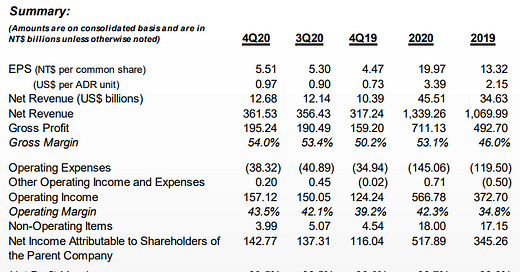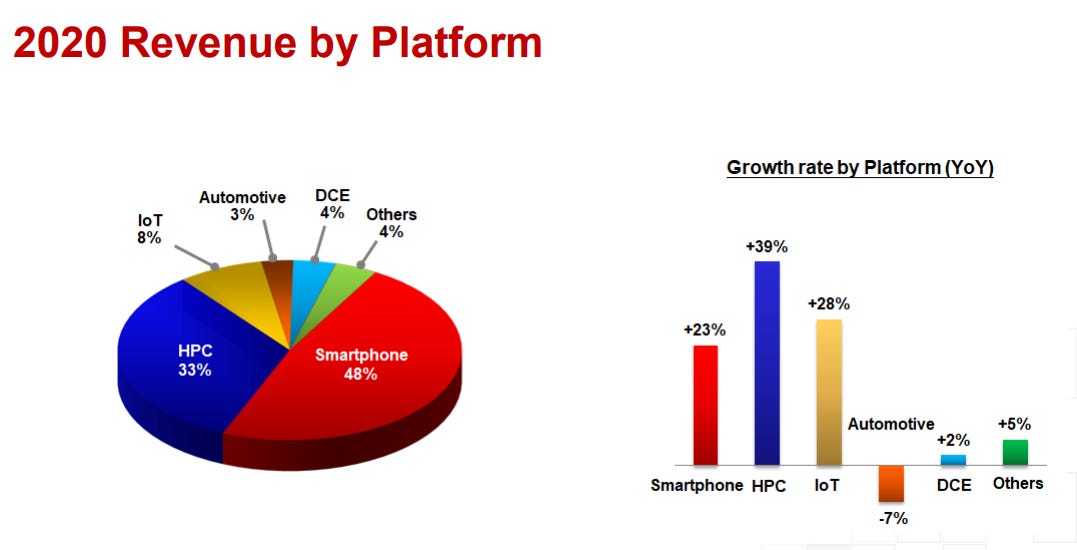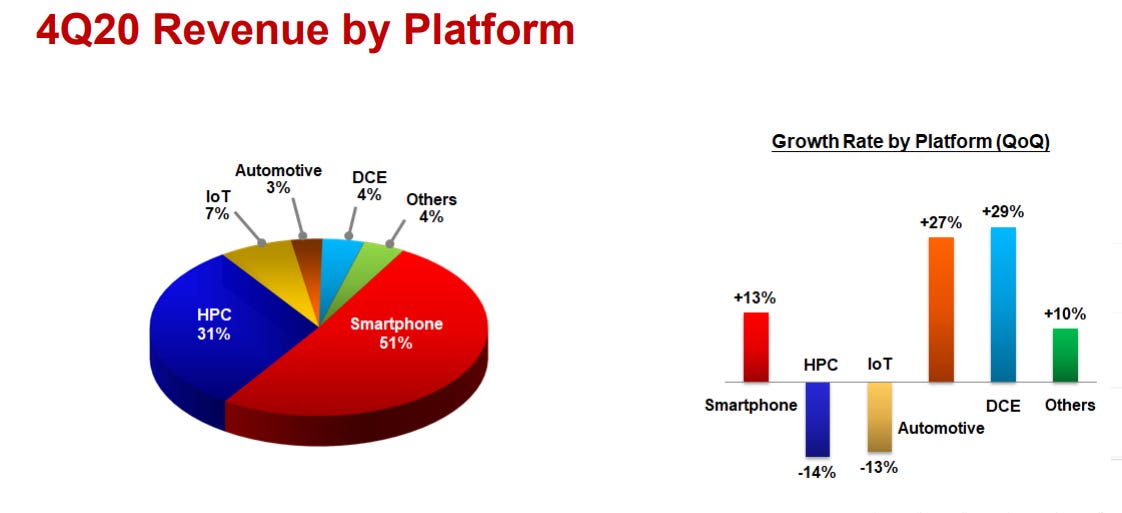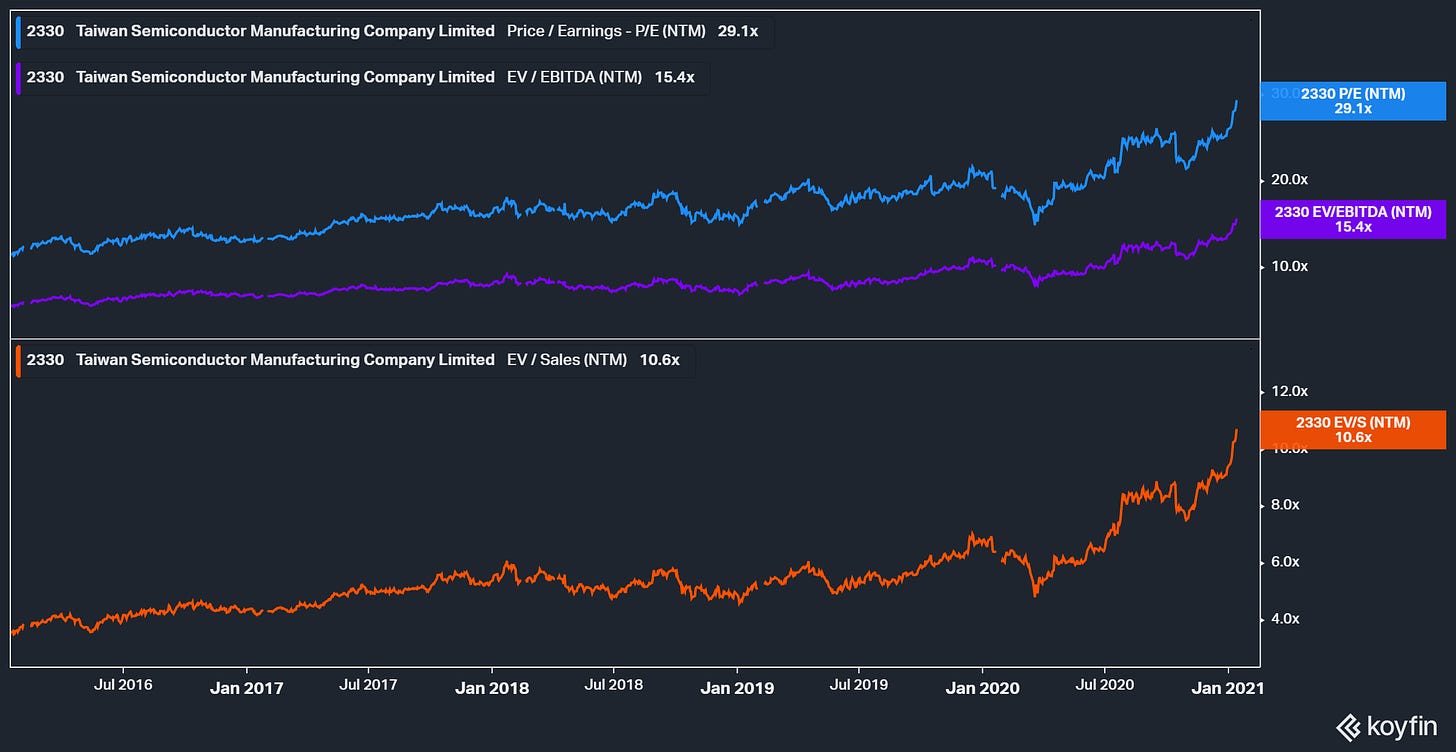

Discover more from Fabricated Knowledge
Taiwan Semiconductor reported earnings today and frankly I was pretty surprised. The thing that shocked me was Capex of guidance of ~$25-28 billion compared to $19 billion in 2020. I wrote about the TSMC consensus guide of ~$21 billion and took that as a very bullish signal for WFE (Wafer Fab Equipment) at ~23% YoY growth.
Now imagine my surprise at $25-$28 billion! That is ~31% to ~47% YoY growth in WFE if this trend holds up for the rest of the industry. To be clear It likely won’t - as Samsung and Intel will grow their capex line items slower. But still, this is meaningfully ahead of even the rosiest expectations. Analysts on the call tried to ask if this capex demand was because they were expecting a new large customer ala Intel, but TSMC avoided answering those questions altogether. Below are some comments from the call I thought were useful.
They commented that the capex intensity was partly because they needed the capacity to grow and take share.
Next, let me talk about our capital intensity outlook. As we have said previously, our long-term capital intensity is in the mid-30s percentage range. However, when we enter a period of higher growth, our CapEx needs to be spent ahead of the revenue growth that will follow, so our capital intensity will be higher. For example, during 2010 to 2014, our CapEx spending increased threefold as compared to the previous few years, and our capital intensity ranged between 38% to 50%. Because of the increased investment, we were able to capture the growth opportunities and deliver about 15% growth CAGR from 2010 to 2015.
And what is even more interesting is that they are spending ahead of demand and expect to accelerate revenue growth higher in the future
Brett, it's -- as I said, it's a bit too early to discuss 2022 in details. But C.C. just mentioned, over the next 5 years, we're looking at a higher range of CAGR.
And also, the CapEx spend this year means future opportunity and growth not just for the next year but also the years after that. So we're looking at multiple years of growth opportunities.
But what I find really interesting is that in the near term it looks to me that Capex is going to grow much faster than revenue for some time. Also, that revenue should and will likely accelerate amid their higher capex spend. But despite this, I don’t think that the capital intensity will abate. Many thought that EUV would lower capital intensity, and I think this is actually the wrong conclusion.
Jen-Chau Huan Notes that:
And for example, the leading-edge technologies, the complexities increases, the CapEx per K, it's more expensive than before. So we are working very hard with the customer to sell our value, the service value, the technology value and also the capacity value and firm up the wafer price. At the same time, we also work very closely with our suppliers to continue to improve our cost so that altogether, we can maintain and earn a proper return in the leading nodes compared to those of the previous few nodes. As a result, we are maintaining our structured profitability goal as 50% of gross margin. Okay?
This looks like price raises to me. Moore’s law slowing is partially going to abate the deflationary aspects of semiconductor technology improving.
And when asked about whether improving EUV productivity would lower capex intensity - the response was actually the opposite of expected:
Well, let me answer that. We continue to improve the EUV's productivity because we are working closely with suppliers. And so far, we -- the improvement is obvious but still not up to our expectation yet. As for the CapEx won't be decreased because of improved productivity, this is in our CapEx plan already.
And actually that each node is becoming more complex - and that EUV is just one of many drivers of this.
Well, whether the CapEx remained high or the CapEx intensity remained high is because of technology complexity. It's actually that N5 is much more complicated than N7, N3 is much more complicated than N5. So most of that CapEx intensity coming from this technology advancement. Of course, EUV is a part of it, but it is not the only one reason.
Another thing to note is capex intensity in terms of the longer-term cycle
Yes. Yes. We mean long term meaning 3 to 5 years. I think 2010 to 2014 can be an example. During that period of time, the capital intensity rose from 38% to 50%, maintaining at high 40s for a couple of years and came down afterwards. Something like that should be a reference. Okay?
This means that likely given their guidance, we will see capex reach ~ the high 40s for a few years yet. 2020 will likely be the first ~50% year and each year will subsequently fall as a percentage of revenue as revenue grows accelerates.
This likely means a much higher and new base for WFE going forward.
Demand Drivers
The other interesting train of thought is what is driving the demand for this. TSMC got asked multiple times what is the driver for the large step up in future revenue, and they answered exactly what I hoped they’d say
Gokul, we don't specifically name one of our HPC applications such as CPU to say that what is the growth rate. But let me tell you that CPU, networking and AI accelerator will be the main growth area in the HPC applications. Did that answer your question?
This of course was trying to see if that CPU (Intel) was a large incremental driver, but I think amid the hype for semiconductor startups, in ~2021/22 we will actually see AI accelerators hit volume. This is exciting as this is largely an incremental demand driver that didn’t exist just 5 years before.
One of the things that I wanted to hear was about seasonality and they answered what I was looking for pretty well. In particular, highlighting multiple end markets will smooth cyclicality.
Laura, let me add some colors. I think our business has been driven traditionally -- in the past few years by smartphones. Starting from this year on, HPC also jumped on the wagons, and therefore, we're looking -- forward looking, we see the traditional seasonality is -- can be moderated with multiple big customers in multiple market segments. So that's our confidence.
The other confidence is our CapEx includes 3-nanometer, also 5-nanometer. Our 5-nanometer is also very strong, stronger than we expected 3 months ago. So those 2 combined to give us the confidence to increase our CapEx.
Additionally, they noted their fastest-growing segments for 2021 will be HPC and Auto, which is largely what I believe. I think it’s hard to believe that Intel's revenue will grow faster than TSMC over the next 5 years, and this is why I think that even if there is some shift to Intel, this is likely because of the new large tech companies. AWS is expecting to offer Trainium in the spring - this could be the incremental demand driver here.
Okay. Randy, for 2021 by platform, we think HPC and automotive growth will be higher than the corporate average growth. Smartphone and IoT will be similar to the corporate average growth in U.S. dollar terms. In terms of our back-end business, we expect it to grow slightly higher than the corporate in 2021. We do not disclose details within the back-end business.
And this is a classic read through on what is driving the near term results - HPC. Since Intel is not on TSMC yet, this shows the de-novo demand from hyper scalers currently.
So I would be curious about if you can give us more details about which applications are you seeing a stronger-than-expected demand. HPC.
High-performance computing, as Wendell just said, will be the major growth driver of our business. And this field is currently under exciting changes. As the high-performance computing's architectures, as you know, from different customers, everybody is striving to get the best performance with different architectures. So many, many -- many more players are getting into this field. So we see a stronger innovation is coming our way on N3 as well as on N5, yes.
I believe and continue to believe that HPC and AI will end up as large of a market as mobile is today. And this incremental growth likely will go to TSMC - but clearly, I like the semicap players more, as near term capital intensity likely outgrows revenue for 2021 and possibly 2022. As TSMC scales N3 / N5 capital intensity will go up and semicap players will benefit massively. The semicap oligopoly is a great place to start. That’s ASML, AMAT, LRCX, KLAC, and TOELY for those not familar.
The Numbers
I will at a high level cover the numbers. First, this was a pretty nice operating profit beat - but not a blowout. Actually, if you squint closely I believe revenue was below consensus revenue of ~$363.43b.
But the part that makes all the difference is the capex. I wrote about this in the past and I still feel strongly about this statement
TSMC is currently the most dominant global fab, and its ROE/ROIC numbers are impressive and improving. Improvements recently are more a function of the semiconductor cycle than of their competitive advantage, but importantly I would say qualitatively their moat has expanded quite a bit since their last 2016 ROE cycle high. I believe that in the next few coming years we could see a new cycle high for ROE/ROC numbers – and if TSMC feels confident that they can invest $17 billion USD at similar (or better) returns, as a shareholder you should be rejoicing. That is the most “money good” investment I am aware of.
This is great for shareholders. They think they can deploy ~40% more capital that’s amazing! And that’s why the stock is up ~10% on the day of earnings despite a slight revenue miss.
Another thing of note is how great the 5nm ramp is going. This is significantly above what I thought it’d be, and 7nm in my eyes was a “mega node”. Part of this was AMD starting to take share, and Intel broadly losing share across this node. However TSMC is gaining a lot of traction in 5nm, and they called 5nm being meaningfully ahead of expectations. Given the 4Q revenue mix, this means that this has to be from Apple (Phone and M1).
Another thing of note that is interesting is that amid a terrible year for auto in 2020, you can start to see green shoots.
Compare that to 4Q20 revenue growth
Auto and digital consumer electronics (DCE) are the fastest-growing segments in 4Q! I think this bolsters the right to be bullish on Auto - which I mentioned briefly in my 2021 outlook. Amid the supply chain disruption, Auto seems like one of the best setups for 2021.
TSMC continues to shock and surprise! I’m frankly shocked, and I have been selling TSMC off because of valuation - partially frustrated that I felt the narrative had outrun the operating results. I was wrong and am not going to sell what shares I continue to own.
But frankly, the market is smart - and we will see if Intel announces to TSMC next Thursday. That headline could move shares even higher.
Anyway, that’s it for today. Thanks for supporting the substack. I am happy that many of ya’ll are starting to see the silicon renaissance in action. The 2021 outlook that I initially had was very bullish - and TSMC not only confirms it but confirms likely my wildest dreams are coming true.
I hope and plan to do a WFE analysis soon. Intel needs to report to confirm results - but I want to leave you with a very simple takeaway; If Intel grows capex in any shape or form WFE is likely on pace to run at ~20%+ for the year. The fastest-growing year in recent memory. Any share gainers in this will likely grow even faster and operational leverage can magnify EBIT and EPS results as well. I am extremely constructive on semicap right now, as I think the market is in shock pricing in some of these results (I am!). More to come later.
If you considered this analysis helpful, please consider subscribing to my substack. I really love covering this space at this crucial moment in time - and your support makes this possible. Thank you!









How much do you consider Taiwanese tension with Ccp? If TSM makes up a significant chunk of portfolio, would you hedge it with INTC in case tensions exceed any expectations?
Thanks for the great article. Just a small note, DCE in company presentations stand for Digital Consumer Electronics rather than Datacenter Comms.
In Q4 2020, 49% of TSM revenue came from advance nodes (7 & 5 nm). Now, in the next couple of years this number is likely to be close to 70-80%. First, this gives a margin of safety that the company can maintain its guided 50% margins. Second, it will enable massive revenue growth as ASP will grow with higher advance node mix.
I personally believe if utilization rates stay as high and forex is favorable, gross margins will likely be 52%-54%. I also think that 10-15% revenue CAGR is conservative guidance, I think they will deliver 15-20% CAGR until 2025 (if not more). Hence, I assume earnings of ~$10 per ADS in 2025, and at a conservative 20 p/e gives $200 for TSM stock in 2025 earnings. I do however take my model as conservative given growing ASP at advance nodes and how fast revenue for the company can grow.